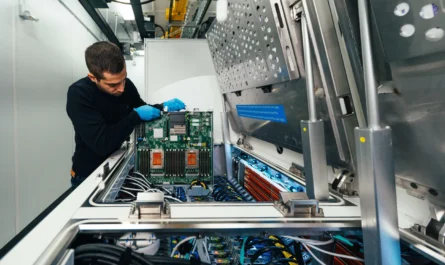The oil and gas industry is on the cusp of a major transformation driven by advances in Artificial Intelligence (AI) and Machine Learning technologies. AI is poised to change the way oil and gas companies find, extract, produce, transport and market their products. From enhancing exploration capabilities to optimizing refining processes, AI will have a significant impact across the energy value chain.
Improving Exploration Success Rates with AI
One of the areas where AI can have the greatest impact is seismic data analysis and reservoir modeling during oil and gas exploration. Analyzing massive volumes of seismic data to identify locations for drilling is a highly complex task that requires processing petabytes of information. Traditionally, this was done manually by geologists and geophysicists which was time consuming and prone to errors.
AI and Machine Learning algorithms can now analyze seismic data at an unprecedented scale and accuracy to map subsurface geological structures with a high degree of precision. Deep learning models are trained on massive datasets containing patterns from thousands of previous exploration and drilling projects. This enables AI systems to detect subtle patterns and anomalies in seismic data that may indicate hydrocarbon deposits that human experts could miss. Companies like Shell, BP and ExxonMobil are already using such AI-powered exploration tools to improve their success rates.
Optimizing Well Placement with Intelligent Reservoir Models
Another key application of Artificial Intelligence (AI) in Oil and Gas is in building high-fidelity digital twins and dynamic reservoir models. These digital representations of oil and gas fields capture all properties of the reservoir based on data from existing wells, seismic surveys, production history and simulations. AI techniques such as neural networks, genetic algorithms and reinforcement learning are used to continuously refine these digital twins based on new data from sensors in wells.
Intelligent reservoir models powered by AI can help optimize well placement, production rates as well as enhanced oil recovery processes. They provide accurate predictions of in-situ fluid properties, flow rates as well as the movement of water and hydrocarbon phases within the reservoir. This helps oil companies maximize extraction from mature fields and brownfields through infill drilling and secondary/tertiary recovery techniques. The models also aid in reservoir management decisions like pressure maintenance and voidage replacement.
Optimizing Drilling Operations with AI and Robotics
AI is finding increasing applications in automating and optimizing oilfield drilling operations. Automated drilling advisory systems use machine learning on vast datasets containing sensory data from past drilling jobs to provide real-time recommendations to drilling engineers. They monitor parameters like weight on bit, torque, pressure pulses and vibration levels to optimize ROP (rate of penetration), drilling hydraulics as well as trajectory maintenance.
Advanced AI-powered systems can even take over routine decision making from human drillers during non-critical phases of the operation. This helps improve safety, efficiency as well as predict and prevent potential downhole problems. Robotics is also transforming oilfield operations with autonomous drilling rigs, workover units and well intervention robots capable of working in hazardous conditions. The combination of robotics, AI, VR and high-fidelity digital twins is paving the way for fully autonomous “lights-out” drilling in the future.
Optimizing Production Operations with AI
AI is revolutionizing oilfield productionoptimization as well. Intelligent production optimization systems leverage machine learning models to maximize extraction from mature reservoirs and optimize facility operations. Sensors installed across the production network continuously monitor parameters like pressure variations, flow rates and equipment health. AI-powered data analytics helps detect anomalies, predict failures as well as optimize artificial lift and enhanced oil recovery techniques in real-time.
This helps oil producers squeeze more reserves out of aging assets through smart reservoir and facility management. Predictive maintenance techniques rely on machine learning from historical sensor data to detect impending failures, resulting in fewer unplanned shutdowns. Automated solutions powered by AI are also optimizing secondary and tertiary recovery processes like waterflooding, steam flooding and gas injection to maximize recovery factors. Overall, these AI-driven optimizations are delivering significant productivity gains of 5-15% for major oil producers.
Transforming Midstream Operations with AI
The midstream segment involving Artificial Intelligence (AI) in Oil and Gas is another major area being transformed by AI. Intelligence pipeline inspection gauges (PIGs) use computer vision, sensors and deep learning to inspect pipelines for defects, cracks or corrosion with far greater accuracy than before. Anomaly detection systems based on neural networks analyze massive volumes of historical inspection data and sensor readings from pipeline SCADA systems.
They help predict risks offailures or leaksand prioritize sections for maintenance or repair. This is improving safety as well as minimizing unplanned downtime and environmental impacts. Other AI applications include intelligentschedulers and optimizersfor pipeline throughput. Advanced solutions use machine learning and predictive algorithms to optimize the flow of crude oil andnatural gas based on production forecasts, storage levels as well as demand predictions. This helps maximize utilization ofpipeline networks andstorage facilities.
Transforming Refining with AI-powered Catalysts and Processes
Refineries rely on complex separation and catalytic cracking processes to convert crude oil into valuable refined products. Traditionally, optimization has relied on engineering know-how, statistical modeling and lab-scale R&D. However, AI and Catalytic Machine Learning are now enhancing these capabilities. Inteligo Catalyst developed an AI technique that can autonomously design new catalyst materials in silico through generative modeling. This has resulted in breakthrough innovations like replacing precious metal catalysts with cheaper alternatives.
Advanced AI-powered systems can also optimize complex refining processes in real-time using data from plant instrumentation. Online multivariate modeling powered by machine learning helps refineries operate individual distillation columns, fractionators, cracker units as well as tail gas treaters at their most efficient points. This helps maximize yields, reduce emissions as well as enhance flexibility to dynamically adapt to changing feedstock slates. Overall, AI-driven digital refineries optimizing hundreds ofprocess variablesare delivering benefits worth millions annually for majors like ExxonMobil and Sinopec.
Transforming Marketing and Trading with AI
The trading and marketing divisions of oil and gas companies are also leveraging AI. Sophisticated predictive analytics and prescriptive algorithms use historical price data, geopolitical events, refinery outages as well as demand trends to forecast commodity prices more accurately. AI-powered systems intelligently analyze structured and unstructured big data sources to identify emerging disruptive trends early on.
*Note:
1. Source: Coherent Market Insights, Public sources, Desk research
2. We have leveraged AI tools to mine information and compile it
About Author - Vaagisha Singh
Vaagisha brings over three years of expertise as a content editor in the market research domain. Originally a creative writer, she discovered her passion for editing, combining her flair for writing with a meticulous eye for detail. Her ability to craft and refine compelling content makes her an invaluable asset in delivering polished and engaging write-ups. LinkedIn

 by
by 


